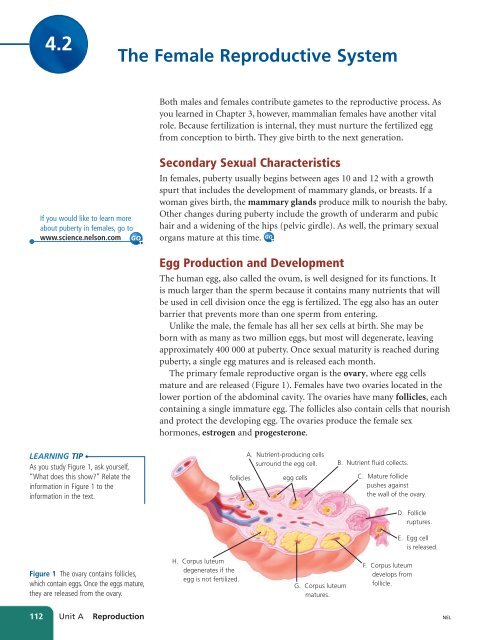Unit A Reproduction
Unit A Reproduction
Unit A Reproduction
You also want an ePaper? Increase the reach of your titles
YUMPU automatically turns print PDFs into web optimized ePapers that Google loves.
4.2<br />
The Female Reproductive System<br />
Both males and females contribute gametes to the reproductive process. As<br />
you learned in Chapter 3, however, mammalian females have another vital<br />
role. Because fertilization is internal, they must nurture the fertilized egg<br />
from conception to birth. They give birth to the next generation.<br />
If you would like to learn more<br />
about puberty in females, go to<br />
www.science.nelson.com GO<br />
Secondary Sexual Characteristics<br />
In females, puberty usually begins between ages 10 and 12 with a growth<br />
spurt that includes the development of mammary glands, or breasts. If a<br />
woman gives birth, the mammary glands produce milk to nourish the baby.<br />
Other changes during puberty include the growth of underarm and pubic<br />
hair and a widening of the hips (pelvic girdle). As well, the primary sexual<br />
organs mature at this time. GO<br />
Egg Production and Development<br />
The human egg, also called the ovum, is well designed for its functions. It<br />
is much larger than the sperm because it contains many nutrients that will<br />
be used in cell division once the egg is fertilized. The egg also has an outer<br />
barrier that prevents more than one sperm from entering.<br />
Unlike the male, the female has all her sex cells at birth. She may be<br />
born with as many as two million eggs, but most will degenerate, leaving<br />
approximately 400 000 at puberty. Once sexual maturity is reached during<br />
puberty, a single egg matures and is released each month.<br />
The primary female reproductive organ is the ovary, where egg cells<br />
mature and are released (Figure 1). Females have two ovaries located in the<br />
lower portion of the abdominal cavity. The ovaries have many follicles,each<br />
containing a single immature egg. The follicles also contain cells that nourish<br />
and protect the developing egg. The ovaries produce the female sex<br />
hormones, estrogen and progesterone.<br />
LEARNING TIP<br />
As you study Figure 1, ask yourself,<br />
“What does this show?” Relate the<br />
information in Figure 1 to the<br />
information in the text.<br />
follicles<br />
A. Nutrient-producing cells<br />
surround the egg cell.<br />
egg cells<br />
B. Nutrient fluid collects.<br />
C. Mature follicle<br />
pushes against<br />
the wall of the ovary.<br />
D. Follicle<br />
ruptures.<br />
E. Egg cell<br />
is released.<br />
Figure 1 The ovary contains follicles,<br />
which contain eggs. Once the eggs mature,<br />
they are released from the ovary.<br />
H. Corpus luteum<br />
degenerates if the<br />
egg is not fertilized.<br />
G. Corpus luteum<br />
matures.<br />
F. Corpus luteum<br />
develops from<br />
follicle.<br />
112 <strong>Unit</strong> A <strong>Reproduction</strong><br />
NEL

















